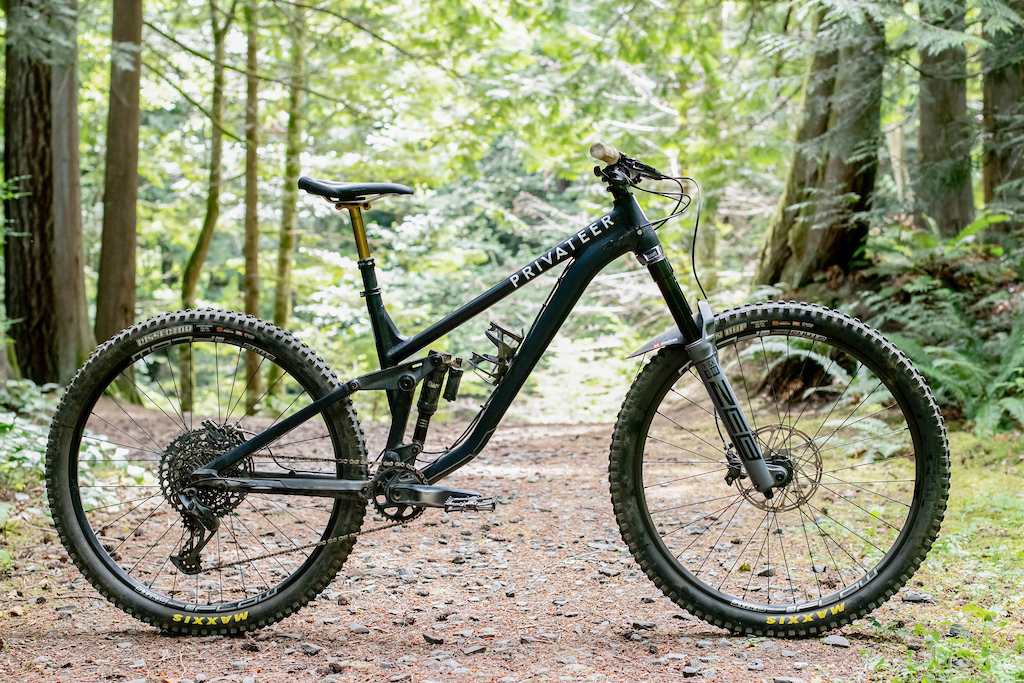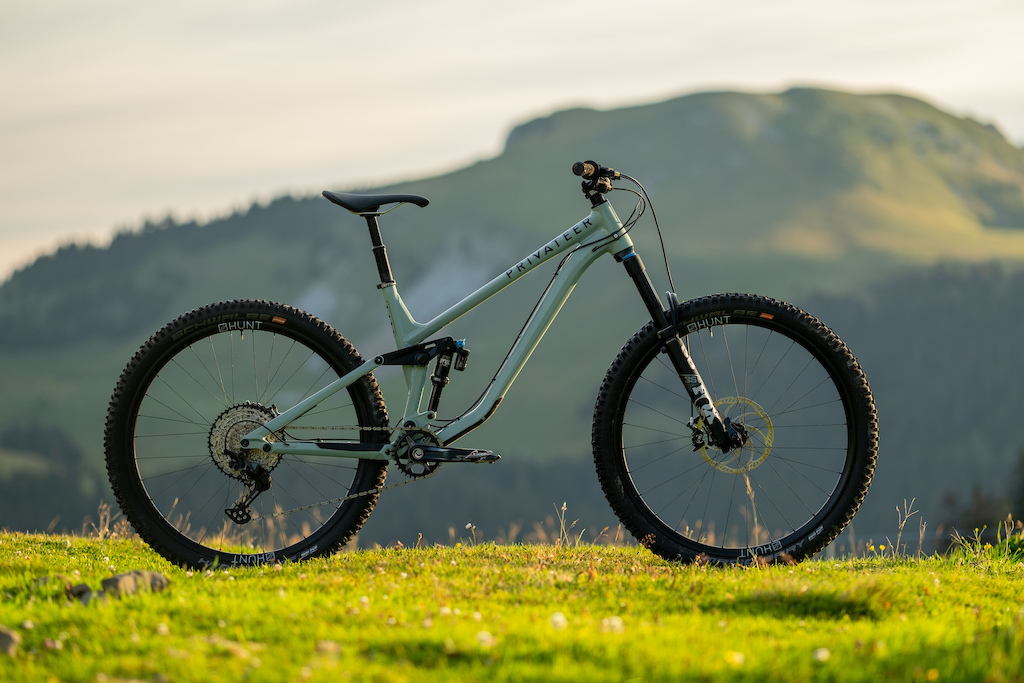Here at Pinkbike, we get inundated with all kinds of questions, ranging from the basic "Can I have stickers?" to more in-depth, soul-searching types of queries like if you should pop the question or what to name your first child. Ask Pinkbike is an occasional column where we'll be hand-picking and answering questions that have been keeping readers up at night, although we'll likely steer clear of those last two and keep it more tech-oriented.
Can I set up a 160mm bike to ride like a 140mm bike?Question: Jhomas.toseph asks on Instagram:
If you've got two bikes with the same leverage curve, but one's short travel and the other is longer (say 141mm vs 161mm travel) would it be possible to replicate the feel of the short travel bike simply by increasing the spring rate on the long travel bike? I'm trying to choose between the Privateer 161 and 141, which look to be almost identical apart from the travel numbers. I don't ride flat out fast trails very often, so would generally prefer a firmer more supportive ride. However, I'm wondering how much of the short travel feel I could achieve on the 161 by running higher shock/fork pressures, whilst still having the option of a plusher ride with deeper sag for bikepark/DH laps. Any help would be very much appreciated! Cheers! | I think the basic answer is yes. If you were to run 26% sag on a 161 and 30% sag on a 141, both will have 42mm of sag. And barring any significant differences in the leverage curve or the shock, that would mean they'd have the same spring rate. Obviously air shocks are non-linear so there will be a difference as the 141 gets towards the end of its travel, but in the normal "pedaling region" (say the first 100mm of travel or so) the wheel rate and therefore the feeling of support vs harshness will be pretty similar. You could add volume spacers to the 161 to get it to feel almost identical. You may never use all the 161's travel when set up like this, but that's not necessarily a bad thing - you could just think of the last 10-20mm of travel as "for emergencies only".
Normally, the problem with running less sag than the bike is designed for is it will give you a higher sagged bottom bracket height and steeper dynamic geometry. But that may be exactly what you're after for flatter, less demanding trails. Plus, the Privateer 141 and 161 have near-identical bottom bracket heights and head angles, so you'd be getting the same sagged geometry anyway if you ran the same number of millimetres of sag.
One difference is the effective seat tube angle, where the 161 measures 80- degrees and the 141 measures just under 79-degrees. If you ran both bikes at the same percentage sag, the extra travel of the 161 would cause it to sit at about the same angle once sagged, but if you set the same absolute sag, it'll be a little steeper. That's not necessarily a bad thing though, and you can always slide the saddle back on the rails if you find it too steep.
Personally, I run about 28% sag on the 161 and I find it to be a very comfortable climber. The steep seat angle makes it feel very purposeful on steep climbs and the high anti-squat suspension means its efficient under power too. It's no cross-country racer, but it pedals well and the 141 is barely lighter.
|
What exactly is meant by fork stiffness?Question: @PDXooo asks:
Please help me understand something. When people speak of fork stiffness (due to stanchion diameter etc.) what are they referring to exactly? Is the flex occurring where the stanchions AND crown meet, or stanchions to lowers...? | Good question. Manufacturers and reviewers often don't specify exactly what they mean by "stiffer", but you can measure fork stiffness in three ways: Fore-aft stiffness (how much does the axle move back and forth for a given force); torsional or steering stiffness (how much does it twist along the steering axis if a torque is applied between the axle and the stem); and lateral (how much does the axle move sideways for a given lateral sheer force). Manufacturers sometimes choose not to specify which they're referring to in order to make their fork seem better. For example, inverted forks are usually stiffer fore-aft but less stiff laterally and torsionally; their manufacturers occasionally forget to mention these last two metrics when talking about stiffness.
Where in the fork chassis most of the flex occurs is hard to answer, but I think the basic answer is "everywhere". Forks are carefully designed using Finite Element Analysis to maximize their stiffness-to-weight ratio, so it wouldn't make sense to have one component in the chain connecting the axle to the frame that was much stiffer - or much less stiff - than all the others. If you look at slow-motion footage of forks flexing, there appears to be some visible flex in all the components (crown, stanchions and lowers).
|
A nice chap I got talking to on the trails a few weeks ago asks:
I get punctures occasionally. Should I bother getting a set of inserts like CushCore, or just heavier-duty tires like DoubleDown casing ones instead of EXO (which has a similar weight penalty)? | It depends on what's causing you to puncture. If it's sharp rocks like flint or slate cutting a hole in the casing, an insert isn't going to help at all. If it's pinch flats, then an insert should reduce the risk of those dramatically, but I can tell you from bitter experience that they're not 100% effective. And remember, if you do puncture and you can't fix the tire with a plug, you'll have to carry the sealant-soaked insert home with you. An insert should help protect the rim from damage to a greater extent than a thicker-casing tire, but again, I can tell you this doesn't always work - I once destroyed a SRAM Roam 60 carbon wheel in the middle of an Alp with CushCore installed after hitting a hidden rock at speed.
The difference in weight between a Maxxis EXO and DoubleDown tire is about 200-250g, while CushCore weighs about 265g per end in 29". However, the thicker DD casing doesn't just add weight, it will also increase rolling resistance. This is because the stiffer sidewall saps more energy when conforming to the ground at the contact patch as the tire rolls along. This difference in rolling resistance is probably more noticeable than the difference in weight between EXO and DD tires in terms of climbing speed. CushCore, on the other hand, is claimed to maintain or even slightly reduce rolling resistance, so the EXO tire with CushCore will likely be a faster setup.
I'd also say that, in the case of CushCore especially, there's a noticeable benefit in terms of ride feel and traction. The tire is more damped, so it skips off the ground less over rough terrain and offers more traction and comfort than a standard EXO casing. A stiffer tire casing will provide more damping too, but with CushCore there's less of a downside in terms of the "wooden" feel over small bumps that you get with stiff tire casings. I've also enjoyed Rimpact's inserts, which offer some of this damping benefit, though to a much lesser extent, at around 100g per wheel. As far as I can tell, Nukeproof ARD, Huck Norris, RockStop and Flat Tire Defender have no real impact on ride feel.
Obviously thicker tires are cheaper than thin tires plus inserts, but some of the more robust inserts (again, CushCore is one of the most long-lived options I've tried) should outlast several sets of tires, and if it saves you from destroying one set of tires in its lifetime, it's practically paid for itself.
|






large crystal granite, you'd be grenading tires all day, every day. I weigh 40 lbs less and have to run Double Down (or equivalent) rear tires to avoid sliced casings.
Maybe it's the KIND of rocks? I'd imagine lots of round rocks, or sandstone, is very different than knife-edge, square-edge, all-over-the-place hardly-any-dirt kind of rocks (which is the case where I'm at).
Currently I'm running 13/16 on 2.6/2.4 (with a special insert) and the grip is phenomenal.
And 2.4 on trail
Both I run 23/27
I’m 185lbs
Cush core on both
DH casing on DH and exo front and rear on trail
(I'm 190, pretty fast, and cant run less than 28psi with double down casing or I'll destroy rims)
I have a buddy who isn't top 5% like me, he's top 1%. He runs cushcore with DD and blows up two wheelsets a season. Here's my explanation: there is a huge gap between top 5% and top 1%. The twenty or so seconds I've managed to follow him on double blacks have been violent beyond my ability. Those extra seconds come from intense forces and lines that wreck bikes.
Tl;dr 5% on strava doesn't mean Fast, and Fast destroys bikes.
Trails around Madrid are "natural",we ride a pile a rocks and junk,nobody can work on the trails,it is not allowed.
In my enduro bike I ride DH or DD tires and inserts.I lost the count on how many wheel sets I have to rebuild in the last 8 years,at 145 pounds going reasonable quick.
EXO means nothing here hahahaha. My last EXO tire flat destroyed my rear wheel so fast I have no chance to save it or minimize the damage.
Yea I’m 175pounds and on EXO 2.5” and I’m currently running 24/28 bc I didn’t my rear rim when I went lower.
I probably need to try some inserts
...
at least here, in the comments "department"
@superman #4.
I am very surprised you top 5 everything and have no flats ever, but that's cool. I use dd and cushcore and get no flats, just rips. I'm 80kg. Run 21-24 psi and can ride a bike. With out cushcore my rims last a season. Sometimes less.
Brilliant!!
I have seen some of those round my way too, you'd recognize them instantly, they are just so damn rocky.
I have named one of them Rocky McPointyRockface..
I run a Dissector rear currently, and a DD without insert is 1176g and a Exo+ with Tannus is 1103. And I can ride less pressure by 1-2psi. I've certainly put a few dings still in the rear from going too low but haven't flatted when I did.
+ CCPro + low pressure gives the illusion of support by not feeling squirmy in sub critical cornering situations.
The best set-up is a light set of rims, EXO+ casing and Tannus tubeless armour... Tannus is light as CushCore XC yet all the benefits of CushCore Pro (support, damping and rim protection). Also way, way easier to deal with and install. Last time I put them in, I only needed to break one bead and didn't dump my sealant.
I say "leave the tire at home" when a mile up my ride this morning my presta valve decided to retire early, and I had to walk/hike back to the car....
At least that's what I've found. My suspension is set up to use ~90-95% of travel on the more steep/technical/fast trails, and thus only uses ~75% of travel for the milder trail systems. Works well and no set up change required.
Personally, the bikes mentioned above, Privateer 140 and 160, have so many similarities in geo, I’d just go with the longer travel and be done with it.
If you live someplace where you can dodge the weight penalty of beefier tires, by all means rock some EXO (or equivalent) casings. But if you end up in Vegas, on the Front Range, or anyplace else with a lot of pointy rocks, you'll end up with a sliced tire pretty quickly.
As for inserts, if you only ride buff jump trails I guess they make sense...........maybe?
After combining trail and DH bike into a single bike, I've always run a rear DH/DD casing, lighter front.
Currently running a rear DD aggressor and the side knobs are shredded with the sidewall threads showing after only 130 miles. Trails here eat wheels and tires. 28 psi rear, 25 front. Any less and denting rims. Never pinch flatted a DD or DH casing.
One for the puzzlers.
Tokens are a plague honestly, they have their place but everyone just crams them in because they think only using 70% travel before it returns with the force of a cannon is better than using 90% travel. But hey, it made my fork bottomless
All while sitting 35% into the travel so a 170mm fork feels like 120mm
Here is an example using more tokens and lower overall pressures. Notice for the middle part of the stroke there is no difference in slope, yet one will get 40mm and the other will get 60mm sag
Original comment was complaining about having to run 40% sag to get the right spring rate (slope)
imgur.com/a/iZg1PrX
Also notice no change in ending force. In this case the fork with more tokens will bottom out more easily because it is not able to absorb as much energy, so in reality the more tokens setup will need to be pumped up more to prevent bottom outs, effectively increasing spring rate, while sitting lower than the no tokens
It's no big stretch to think that tokens/spacers are a progressive crutch which reduces travel, and that the biggest manufacturers are in a competition to produce plastic waste
And yep, lowest line is most tokens, highest is least.
The top air spring line (0 token) rises 400n in the space of 66mm. The line is relatively flat in the middle area, so it's roughly 6n/mm or 35lb-in. The lowest line looks a touch softer at the same area. The coil spring is 8n/mm or 45 lb-in. You can really see the air spring effect of firmer initial stroke and bottoming stroke, but soft midstroke. 0 tokens will have less sag than the coil, but offer less support due to the lower effective midstroke springrate
Tokens have their place, the only use for them IMO is to increase spring rate without increasing ride height, to maintain geometry. ie i'm at 15% sag and i want to run it firmer but that would further reduce my negative travel and impact my geo. So you can pop a token in.
Sorry for the wall of text i just found that graph interesting
What pops/cuts easier? A balloon blown up super firm to max inflation or a soft balloon blown up halfway that can conform around sharp pointy things? With cushcore you can drop 5-10 psi from the psi required to avoid wrecking rims & getting pinchflats. This then allows you tire to conform around the pointy sharp razor rocks on the trail and reduces the chances of sidewall slashes and punctures. Can it still happen, of course. But it happens alot less then a rock-hard sidewall
I’ve installed them by hand on aluminum rims. carbon is another story.
Like others, I haven’t had a single flat since switching to DD/DH casings. when I ran exo casings, random little things would slice my tires.
I ran cushcore for 3 years, and then took it out and barely noticed a difference.
The cushcore users end up running shitty xc tires with lousy grip/bad tread patterns or zero side wall support, and then claim the insert makes up for all the shortcomings of the tires. They also run crazy low pressures that increase the rolling resistance, as well as the insert creating a flatter tire profile and increasing the resistance.
One of my good friends was a long time cushcore rep. that claim cushcore makes about being about to finish your ride on a completely flat tire is BS. he destroyed his rim just riding a fireroad back to his car.
I run DD style tires, and 23-24 front/25/26 rear. maybe i’ll run 22 in the front if it’s super steep.
That low rebound effect cushcore claims is actually more of a result of the rubber compound in your tires. Some times are very bouncy; otherwise shave been engineered with rubber that rebounds much slower. it matters.
You need a good amount of torque to hold the wheel in place,in MTB bikes it is not a problem,but in some other bikes it is.
If you don’t want to get flat tires, try improving your bike handling skills and line choice, instead of relying on a gimmick to prevent flat tires.
Make a mobile app